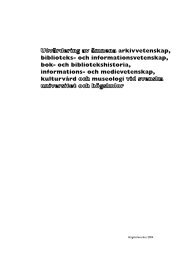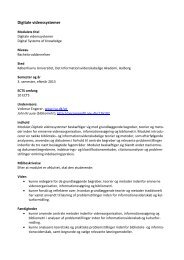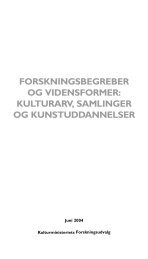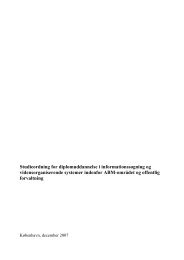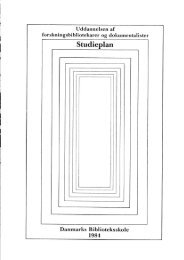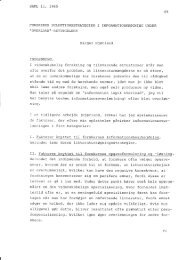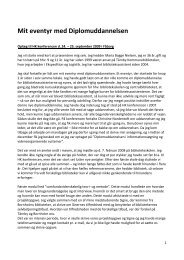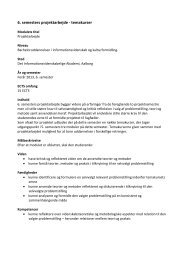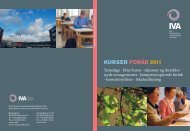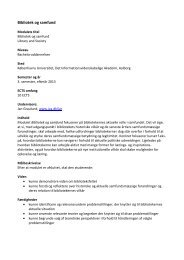Bibliometriske kort og citationsanalyse som vidensorganiserende ...
Bibliometriske kort og citationsanalyse som vidensorganiserende ...
Bibliometriske kort og citationsanalyse som vidensorganiserende ...
Create successful ePaper yourself
Turn your PDF publications into a flip-book with our unique Google optimized e-Paper software.
<strong>Bibliometriske</strong> <strong>kort</strong> <strong>og</strong><br />
<strong>citationsanalyse</strong> <strong>som</strong><br />
<strong>vidensorganiserende</strong><br />
metoder<br />
Jeppe Nicolaisen<br />
Lektor, Ph.d.<br />
Danmarks Biblioteksskole
Det kan forekomme nærved blasfemisk at<br />
påstå, at man kan sige n<strong>og</strong>et centralt om<br />
videnskab bare ved at tælle antal sider<br />
eller antal tidsskrifter på et felt. Er man<br />
ikke nødt til at læse afhandlingerne, for at<br />
se om de er n<strong>og</strong>et værd?<br />
Tor Nørretranders (2007, s. 126)
Fremover bør vi anlægge internationale,<br />
objektive kriterier for tildeling af<br />
forskningsmidler. Det vil bringe dansk<br />
forskning op i verdensklasse. Objektiv,<br />
international vurdering af forskningens<br />
kvalitet gør det meget nemt at kende<br />
excellent forskning fra den jævne<br />
forskning.<br />
Børge Grønne Nordestgaard (2007, s. 9)
Bibliometri<br />
All studies which seek to quantify<br />
processes of written communication<br />
Pritchard (1969, s. 348)
Bibliometriens anvendelser<br />
• Informationssøgning<br />
- Referencer, citationer, links<br />
• Forskningsevaluering<br />
- Forfattere, tidsskrifter, institutioner, lande<br />
- ’Collection management’<br />
• Vidensorganisation<br />
- Klyngeanalyse, bibliometriske <strong>kort</strong>
Grundlæggende metoder<br />
• Publikationsanalyse<br />
• Citationsanalyse
Publikationsanalyse<br />
• Kvantitative målinger på dokumentsamlinger.<br />
• Oftest optællinger af indholdet i et eller flere af<br />
de bibli<strong>og</strong>rafiske felter i en afgrænset del af en<br />
bibli<strong>og</strong>rafisk database.<br />
• Bl.a. optællinger af forfatteres, institutioners eller<br />
landes videnskabelige produktion fordelt på<br />
emne, tidsskrifter osv.
Citationsanalyse<br />
• Kvantitative studier af dokumenters litteraturlister<br />
• Man skelner mellem to former for<br />
<strong>citationsanalyse</strong>r:<br />
- Referencer fra en samling dokumenter<br />
- Citationer til en samling dokumenter
eference<br />
A citation B<br />
Tid<br />
Dokument B refererer til dokument A. Dokument A modtager en citation fra dokument B.
Citationsdata<br />
generelle problemer<br />
Seglen (1996) [oversat fra norsk]:<br />
• References are selected because of their usefulness for the author,<br />
which is <strong>som</strong>ething different from their quality<br />
• Only a small fraction of all used material is cited<br />
• General knowledge is not cited<br />
• Knowledge is often cited from secondary sources<br />
• Documents supporting an authors arguments are cited more often than<br />
other documents<br />
• Flattering (citing editors, potential referees and other authorities)<br />
• Show-of (citing hot new “in”-articles)<br />
• Reference copying (references provided by other authors)<br />
• Conventions. In biochemistry, for example, methods are cited but not<br />
reagents<br />
• Self citations
Bibliometriens forsvar<br />
Small (1987, s. 339):<br />
The issue is not whether we can rely on reference lists in<br />
individual cases as complete sets of influences (we cannot), but<br />
rather whether references can be used statistically, in the<br />
aggregate, as an indicator of influence.<br />
Nederhof & Van Raan (1987, s. 326):<br />
… by no means the assumption is necessary, that scientists cite<br />
in their papers all work used in their research but still, citations<br />
can be used to monitor scientific influence.
Bibliometriens forsvar<br />
Cawkell (1976, s. 3):<br />
Citation anomalies [in sence of ”excessive selfcitations,<br />
plagiarism of references, careless or<br />
omitted references etc.] have little effect - they<br />
are like random noise in the presence of strong<br />
repetitive signals.
Gennemsnitsmantraet<br />
Citation analysts assume that the<br />
biases and deficiencies of individual<br />
citers are repaired to a tolerable<br />
degree by the combined activity of<br />
the many.<br />
White (2001, s. 102)
Gennemsnitsmantraet<br />
Altså:<br />
Hvis <strong>citationsanalyse</strong>r foretages på store datamængder vil man<br />
f.eks. kunne eftervise en nøje sammenhæng mellem kvalitet OG<br />
antal citationer.<br />
Jo flere citationer – jo større kvalitet…<br />
Citationer<br />
Kvalitet
Bornsteins hypotese<br />
If a relationship between citation<br />
frequency and research quality does<br />
exist, this relationship is not likely to be<br />
linear. The relationship between<br />
research quality and citation frequency<br />
probably takes the form of a J-shaped<br />
curve.<br />
(Bornstein 1991, s. 31)
Citationsfrekvens<br />
Ekspertvurdering
J-kurve?<br />
1. En samling dokumenter<br />
2. En samling ekspertvurderinger af 1<br />
3. En samling citationer til 1<br />
Stikprøven:<br />
1. Bøger anmeldet i tidsskriftet Contemporary Sociol<strong>og</strong>y<br />
mellem 1985-1994<br />
2. Ratings fra databasen Sociol<strong>og</strong>ical Abstracts<br />
3. Citationer søgt i Social Science Citation Index (5-års<br />
citationsvindue)
20,00<br />
Citations (independent variable)<br />
15,00<br />
10,00<br />
5,00<br />
0,00<br />
Favorable<br />
Very favorable<br />
Neutral<br />
Very unfavorable<br />
Unfavorable<br />
Evaluation (dependent variable)<br />
Nicolaisen, J. (2002).<br />
The J-shaped distribution of citedness.<br />
Journal of Documentation, 58(4): 383-395.<br />
Resultat (medianen)<br />
W<br />
W<br />
W<br />
W<br />
W
<strong>Bibliometriske</strong> <strong>kort</strong><br />
Kort over viden<strong>som</strong>råde baseret på<br />
co-citation eller bibli<strong>og</strong>rafisk kobling<br />
Ofte visualiseres relationer mellem<br />
citerede forfattere, tidsskrifter eller<br />
institutioner, men f.eks. kan den<br />
semantiske distance mellem begreber<br />
<strong>og</strong>så visualiseres i sådanne <strong>kort</strong>
Co-citation<br />
B<br />
A<br />
C<br />
A <strong>og</strong> B findes begge i C’s litteraturliste
Bibli<strong>og</strong>rafisk kobling<br />
A<br />
B<br />
C<br />
A findes både i B <strong>og</strong> C’s litteraturliste
Citationsnetværk<br />
14 <strong>og</strong> 17 er bibli<strong>og</strong>rafisk koblede 3 <strong>og</strong> 4 er co-citerede
Co-citationsmatrix<br />
1 2 3 4 5 6 7 8 9 10 11 12 13 14 15<br />
2 612<br />
3 935 536<br />
4 338 236 270<br />
5 0 0 0 0<br />
6 69 21 50 7 94<br />
7 4 0 6 1 283 360<br />
8 27 7 34 4 101 2025 555<br />
9 18 3 16 1 98 113 42 45<br />
10 35 6 30 2 136 80 28 40 2817<br />
11 9 4 11 2 88 165 22 44 3086 2151<br />
12 20 11 26 5 95 192 20 42 3241 2172 4479<br />
13 10 5 14 2 94 83 7 30 787 589 371 430<br />
14 14 7 14 1 75 99 13 37 660 452 352 405 8213<br />
15 22 11 17 1 126 106 11 44 606 650 374 420 13327 9790<br />
16 23 13 29 1 290 242 30 79 1251 1006 808 994 28405 * 18075 31330 *<br />
Co-citationsfrekvenser for 16 psykol<strong>og</strong>itidsskrifter (Nicolaisen, 2004)
Statistisk dataanalyse
Cocitation map of library and information science research, 2000-2004 (Åström, 2007)
Man bliver hvad man spiser!<br />
Åström (2007)
Fortolkning<br />
Citation analysis is not a shortcut to be<br />
used as a substitute for thinking<br />
(f.eks. Egghe & Rousseau, 1990, s. 226)
Introduction to Informetrics (1990)<br />
We expect this book to be of help to the informetrics<br />
teacher in organising his or her course and to be<br />
interesting and useful both as a course book and as a<br />
background reading for students in library and<br />
information science (Egghe & Rousseau 1990, s. v).
Fortolkning<br />
Citationsteori
Kulturel disciplinering<br />
Begreber, mening, viden,<br />
informationsbehov, relevanskriterier, etc.<br />
formes i diskursfællesskaber, f.eks. i<br />
videnskabelige discipliner, fag,<br />
domæner.
Domæneanalyse<br />
Forstå domænets<br />
- Ontol<strong>og</strong>i<br />
- Epistemol<strong>og</strong>i<br />
- Sociol<strong>og</strong>i
Fortolkningens grundlag<br />
• Videnskabsfilosofi<br />
• Videnskabshistorie<br />
• Videnskabssociol<strong>og</strong>i
Referencer<br />
• Bornstein, R.F. (1991). The predictive validity of peer review: A neglected issue.<br />
Behavioral and Brain Sciences, 14(1): 138-139.<br />
• Cawkell, A.E. (1976). Understanding science by analysing its literature. The<br />
Information Scientist, 10(1): 3-10.<br />
• Egghe, L. & Rousseau, R. (1990). Introduction to Informetrics: Quantitative Methods<br />
in Library, Documentation and Information Science. Amsterdam, NL: Elsevier.<br />
• Nederhof, A.J. & Van Raan, A.F.J. (1987). Citation theory and the Ortega hypothesis.<br />
Scientometrics, 12(5-6): 325-328.<br />
• Nicolaisen, J. (2004). Social Behavior and Scientific Practice – Missing Pieces of the<br />
Citation Puzzle [Ph.d.-afhandling]. København: Danmarks Bibliotekskole.<br />
• Nordestgaard, B. G. (2007). Et strejf af nepotisme [Kronik]. Jyllands-Posten, 27.<br />
august.<br />
• Nørretranders, T. (2007). Civilisation 2.0: Miljø, fællesskab <strong>og</strong> verdensbillede i<br />
linkenes tidsalder. [Frederiksberg]: Thaning & Appel.
• Pritchard, A. (1969). Statistical bibli<strong>og</strong>raphy or Bibliometrics?. Journal of<br />
Documentation, 24: 348-349.<br />
• Seglen, P.O. (1996). Bruk av siteringer <strong>og</strong> tidsskriftimpaktfaktor til<br />
forskningsevaluering. Biblioteksarbejde, 48: 27-34.<br />
• Small, H. (1987). The significance of bibli<strong>og</strong>raphic references. Scientometrics, 12(5-<br />
6): 339-341.<br />
• White, H.D. (2001). Authors as citers over time. Journal of the American Society for<br />
Information Science and Technol<strong>og</strong>y, 52(2): 87-108.<br />
• Åström, F. (2007). Changes in the LIS research front: Time-sliced cocitation analyses<br />
of LIS journal articles, 1990-2004. Journal of the American Society for Information<br />
Science and Technol<strong>og</strong>y, 58(7): 947-957.




